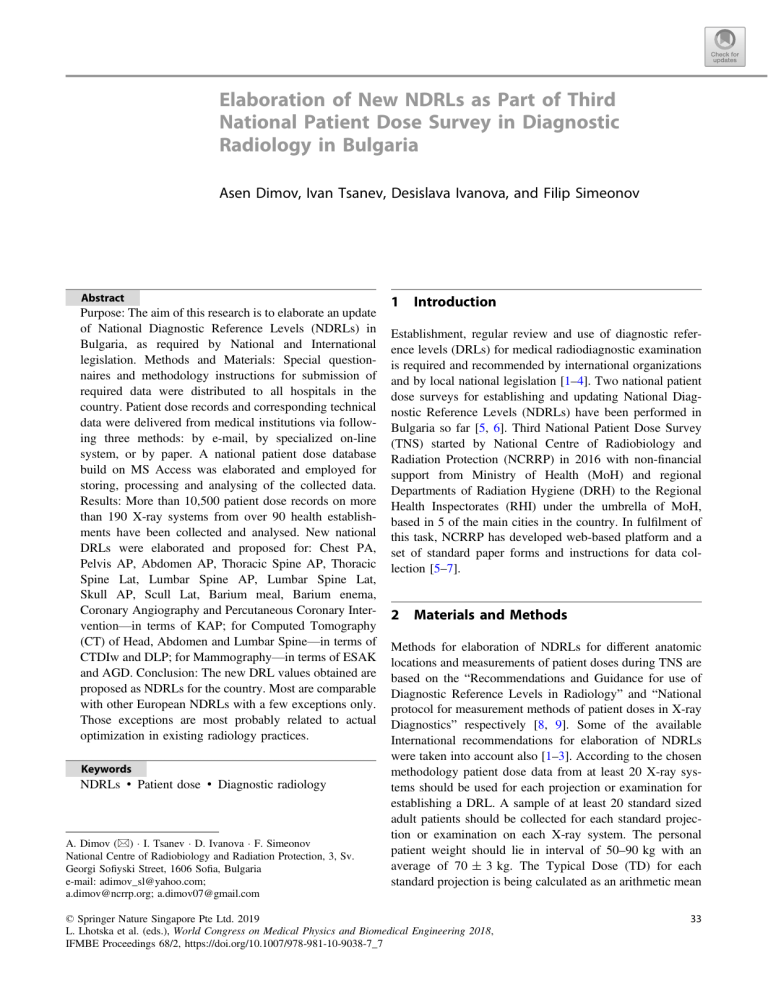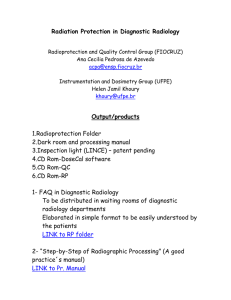
Elaboration of New NDRLs as Part of Third National Patient Dose Survey in Diagnostic Radiology in Bulgaria Asen Dimov, Ivan Tsanev, Desislava Ivanova, and Filip Simeonov Abstract Purpose: The aim of this research is to elaborate an update of National Diagnostic Reference Levels (NDRLs) in Bulgaria, as required by National and International legislation. Methods and Materials: Special questionnaires and methodology instructions for submission of required data were distributed to all hospitals in the country. Patient dose records and corresponding technical data were delivered from medical institutions via following three methods: by e-mail, by specialized on-line system, or by paper. A national patient dose database build on MS Access was elaborated and employed for storing, processing and analysing of the collected data. Results: More than 10,500 patient dose records on more than 190 X-ray systems from over 90 health establishments have been collected and analysed. New national DRLs were elaborated and proposed for: Chest PA, Pelvis AP, Abdomen AP, Thoracic Spine AP, Thoracic Spine Lat, Lumbar Spine AP, Lumbar Spine Lat, Skull AP, Scull Lat, Barium meal, Barium enema, Coronary Angiography and Percutaneous Coronary Intervention—in terms of KAP; for Computed Tomography (CT) of Head, Abdomen and Lumbar Spine—in terms of CTDIw and DLP; for Mammography—in terms of ESAK and AGD. Conclusion: The new DRL values obtained are proposed as NDRLs for the country. Most are comparable with other European NDRLs with a few exceptions only. Those exceptions are most probably related to actual optimization in existing radiology practices. Keywords NDRLs Patient dose Diagnostic radiology A. Dimov (&) I. Tsanev D. Ivanova F. Simeonov National Centre of Radiobiology and Radiation Protection, 3, Sv. Georgi Sofiyski Street, 1606 Sofia, Bulgaria e-mail: adimov_sl@yahoo.com; a.dimov@ncrrp.org; a.dimov07@gmail.com 1 Introduction Establishment, regular review and use of diagnostic reference levels (DRLs) for medical radiodiagnostic examination is required and recommended by international organizations and by local national legislation [1–4]. Two national patient dose surveys for establishing and updating National Diagnostic Reference Levels (NDRLs) have been performed in Bulgaria so far [5, 6]. Third National Patient Dose Survey (TNS) started by National Centre of Radiobiology and Radiation Protection (NCRRP) in 2016 with non-financial support from Ministry of Health (MoH) and regional Departments of Radiation Hygiene (DRH) to the Regional Health Inspectorates (RHI) under the umbrella of MoH, based in 5 of the main cities in the country. In fulfilment of this task, NCRRP has developed web-based platform and a set of standard paper forms and instructions for data collection [5–7]. 2 Materials and Methods Methods for elaboration of NDRLs for different anatomic locations and measurements of patient doses during TNS are based on the “Recommendations and Guidance for use of Diagnostic Reference Levels in Radiology” and “National protocol for measurement methods of patient doses in X-ray Diagnostics” respectively [8, 9]. Some of the available International recommendations for elaboration of NDRLs were taken into account also [1–3]. According to the chosen methodology patient dose data from at least 20 X-ray systems should be used for each projection or examination for establishing a DRL. A sample of at least 20 standard sized adult patients should be collected for each standard projection or examination on each X-ray system. The personal patient weight should lie in interval of 50–90 kg with an average of 70 ± 3 kg. The Typical Dose (TD) for each standard projection is being calculated as an arithmetic mean © Springer Nature Singapore Pte Ltd. 2019 L. Lhotska et al. (eds.), World Congress on Medical Physics and Biomedical Engineering 2018, IFMBE Proceedings 68/2, https://doi.org/10.1007/978-981-10-9038-7_7 33 34 of the relevant dosimetric quantity for the sample of patients. This approach was chosen, since TNS was designed and started in 2016 prior to the official publication of new recommendations of International Commission of Radiological Protection (ICRP), as well as for purposes of easier comparison with previous national and international studies performed so far [1, 10–12]. For children slightly different approach based on median value of dosimetric quantity for the sample of patients is employed for elaboration of typical dose on each X-ray system in accordance with European Guideline [13]. Bulgarian guidance as well as foreign protocols recommends that for adult patients NDRL shell be defined closer to the third quartile of distribution of the typical doses estimated for each projection, examination or procedure. A national patient dose database build on MS Access was elaborated and employed for storing, processing and analysing of collected data [14]. A. Dimov et al. For mammography the reported parameters are: tube potential (kVp); target/filter combination; exposure tube current and time product (mAs); half value layer (HVL); tube output (µGy/mAs); optical density (OD for film-screen systems); source to breast support distance (mm) and patient data. In the mammo quality control tests measurements of incident air kerma (IAK) was also implemented. Incident air kerma is the air kerma from the incident beam on the central x-ray beam axis at the focal-spot-to surface distance at the skin entrance plane. The average absorbed dose in the glandular tissue in a uniformly compressed breast (AGD) can be determined by first getting the IAK measurements on the standardized 45 mm PPMA phantom and standard breast. In TNS AGD is calculated according to the method recommended by the EUREF European guidelines for quality assurance in mammography screening [16]. AGD is derived by calculation using the following formula: AGD ¼ IAK g c s, 2.1 Organization and Data Collection During Third National Survey Four methods of data collection have been employed: A. Using internet based platform for automatic sending: www.drl-bg.com [6]; B. Via electronic tables sent by e-mail to the electronic address of the survey: rzmo@ncrrp.org; C. Via paper hard copy by post mail; D. Via information on local typical doses defined in Health Establishments. All information including terms and conditions for data collection and submission was made available on web page of the TNS [7]. On this web page following information is available for download on both MS Excel and Adobe Acrobat format files: a Short and a Full Instruction for data collection; all necessary forms for registering of X-ray systems properties and patient dose registration forms for all types of Diagnostic Radiology Examinations. These forms include patient’s anthropomorphic data; main exposure parameters; dosimetric quantities recommended by IAEA TRS 457 and ICRP: measured Kerma Area Product (KAP); displayed dose index in case of Computed Tomography (CT): CTDIw, CTDIvol or DLP [1, 15]. The web page has also a link to the on-line platform for registering of patient doses for those sites, which do prefer to use this method of data submission to NCRRP [6]. Calls to the Health Institutions to participate in TNS were published on the web page of TNS as Circular Letters of the Director of NCRRP and the Minister of Healthcare [5, 7]. ð1Þ recommended by European protocols and IAEA TRS 457 Code of Practice [15]. Mammography dose survey included 33 X-ray systems: 17 in hospitals and 16 in Ambulances or in smaller Medical Centres. Different systems were equipped with different detectors: 20 X-ray units with Film Screen Combinations (FSC); 5 with Computed Radiography (CR) plates and 6 with a Direct Digital Radiography (DDR) detector. 3 Results A total number of 10,565 patient dose records from 91 Health Establishments were collected at NCRRP, as corresponding numbers per modality were as follows: 5731; 1793; 1100; 1237; 704, for: Radiography; Computed Tomography (CT); Mammography; Interventional Cardiology and Fluoroscopy respectively. Those data comprised 195 X-ray systems distributed as follows: 81% in Hospitals and 19% in Ambulances and smaller Medical Centres. 58 of the X-ray units were situated in the Capital—Sofia, 41 in bigger cities and 96 in middle and small size cities. About 67% of patient dose data were submitted via e-mail and about 22% by post mail on paper—via above mentioned methods B and C respectively. Submission of data via input in the web based system (Method A) appeared to be not a popular choice for Health establishments participated in TNS, although it was highly recommended by MoH and NCRRP as the primary submission choice. Submission of information on local typical doses elaborated in Health Establishments (Method D) appeared to be not a preferred choice either. Such dosimetric data were collected mainly for Elaboration of New NDRLs as Part of Third … 35 Table 1 NDRLs values from TNS and SNS given in KAP (lGy m2) for radiography projections and fluoroscopy Ba examinations Chest PA Abd AP LS AP LS Lat Pelv AP TS AP TS Lat Skull AP Skull Lat Ba enema Ba meal TNS 45 300 240 360 230 110 220 80 75 1840 1570 SNS 40 – 300 400 400 – – 4000 1800 Table 2 NDRLs values from TNS, SNS and other NDRLs for ca and PCI given in KAP (lGy m2) Survey TNS SNS CA 4600 4000 PCI 13400 14000 EU IE, 2009 6000 5310 AU, 2014 5865 3600 UK, 2010 – 8400 12900 4000 Table 3 NDRLs values from TNS, SNS and EU for CT of head, chest, abdomen and lumbar spine given in DLP (mGy cm), Cw (mGy) and Cvol (mGy) Head TNS Chest Abdomen Lumbar spine DLP Cvol Cw DLP Cvol Cw DLP Cvol Cw DLP Cvol Cw 1000 60 80 500 16 18 470 18 17 580 20 19 SNS 1000 – 60 550 – 25 600 – 30 – – – EU 1000 60 – 400 10 – 800 25 – 500 35 – Table 4 Third quartile values for AGD and ESAK obtained at phantom and patients studies at TNS and NDRLs obtained from SNS Patients Phantom Phantom AGD (mGy) 3-rd quartile ESAK (mGy) 2.4 SNS NDRL 2.3 12 2.3 12 Table 5 Preliminary NDRLs from TNS for paediatric radiography of chest 0–1 years old 1–5 years old 5–10 years old 10–15 years old 8 10 16 2 KAP (µGy m ) TNS 6 mammography units with assistance and input from an external medical physics group providing quality control (QC) service to most of mammography systems participated in TNS. NDRLs obtained from TNS and SNS for Anterior-Posterior (AP), Posterior-Anterior (PA), or Lateral (Lat) Radiography projections of: Chest; Abdomen (Abd); Lumbar Spine (LS); Pelvis (Pelv); Thoracic Spine (TS); Skull (SK); as well as Fluoroscopy Barium (Ba) Contrast studies are shown in Table 1 [6]. Respective data for Coronary Angiography (CA) and Percutaneous Coronary Intervention (PCI) obtained from TNS, SNS, European (EU) and some foreign surveys are shown in Table 2 [6, 10]. NDRLs for CT given in DLP (mGy cm), CTDIw (Cw) (mGy) and CTDIvol (Cvol) obtained from TNS, SNS and EU study are shown in Table 3 [6, 10]. Table 4 shows calculated AGD and ESAK from Phantom and AGD from Patient mammography exposure data. Last are recommended as NDRLs for mammography. Preliminary NDRLs for paediatrics in frame of TNS are obtained for Chest X-ray radiography projection only. Their values are displayed at Table 5. A more complete set of tables with detailed statistics can be obtained from the author. 4 Discussions Most values of Bulgarian NDRLs determined during TNS for Radiography projections and Fluoroscopy Barium Contrast studies are closer to other European countries NDRLs with exception for Chest PA [12]. Higher NDRL for 36 A. Dimov et al. Chest PA is mainly due to commonly used non-optimal “soft” technique with potential of the tube significantly lower than recommended along with anti-scatter grid put always in place which is a commonly observed practice [17]. Differences in SNS and TNS results are due mainly to change in equipment technology of X-ray imaging systems in place. Decrease in NDRLs is observed in all examinations with an exceptions for CA. Increase in NDRL value for this examination is explained with smaller and not so representative patient samples in SNS in comparison with TNS. For PCI for example, this trend is not valid and during TNS we obtained lower then SNS value as a NDRL [11]. Difference in NDRL values for AGD obtained from phantom and patient exposure data is related probably to lack of precise information for Anode-Filter combinations on some of X-ray systems in study, which decreased the number of systems included in Phantom based AGD assessment. The smaller proportion of patient data submitted by the health establishments using the “on-line data collection platform” (Method A.) might be related to its present user interface design and a need for its further development, improvement and promotion. 5 Conclusions Third national patient dose survey collected significantly bigger amount of data than first and second national surveys and hence appeared to be more representative for the country. NDRLs are determined for more Diagnostic Radiology Examinations. Successful realization of TNS became possible due to joint efforts of NCRRP staff, active involvement of Radiation control departments of Regional Health Inspectorates (RHI), medical physicist and other responsible staff in the health establishments in the country and principal support from Management of NCRRP and the Ministry of Health. Conflict of Interest The authors declare that they have no conflict of interest. Statement of Informed Consent Informed consent was obtained from all individual participants included in the study. Protection of Human Subjects and Animals in Research All procedures performed in studies involving human participants were in accordance with the ethical standards of the institutional and/or national research committee and with the 1964 Helsinki declaration and its later amendments or comparable ethical standards. References 1. Diagnostic reference levels in medical imaging. ICRP Publication 135. Ann. ICRP 46(1) (2017). 2. Radiation protection and safety of radiation sources: International basic safety standards. IAEA safety standards series No. GSR Part 3. IAEA, Vienna (2014). 3. Council Directive 2013/59/Euratom of 5 December 2013 laying down basic safety standards for protection against the dangers arising from exposure to ionising radiation, and repealing Directives 89/618/Euratom, 90/641/Euratom, 96/29/Euratom, 97/43/Euratom and 2003/122/Euratom. Official Journal of the European Union, L 13, 17 January 2014, 1–73 (2013). ISSN 1977-0677. 4. Ordinance N.o30 of the Ministry of Health for protection of individuals at medical exposure, promulgated in State Gazette № 91 of November 15 (2005) (in Bulgarian). 5. Vassileva J, Dimov A, at al. Bulgarian experience in the establishment of reference dose levels and implementation of a quality control system in diagnostic radiology. Radiation Protection Dosimetry, Vol. 117, No. 1–3, 131–134 (2005). 6. Vassileva J., Ingilizova K. Dimov A., et al. National survey of patient doses in diagnostic and interventional radiology and nuclear medicine 2002–2013. NCRRP, Sofia (2013), ISBN: 978-619-90135-4-0. 7. Karadjov, A. Dimov, A. Vassileva, J. Anatschkowa, E. Recommendations and guidance for the use of the diagnostic reference levels in radiology. EC Phare Project: Radiation protection and safety in medical use of ionising radiation, Reference Number: BG/2000/IB/EN 01–05, National Centre of Radiobiology and Radiation Protection, Bulgaria (2003). 8. Karadjov, A. Dimov, A. Vassileva, J. Anatschkowa, E. Protocol on the methods for patient dose measurements in x-ray diagnostics. EC Phare Project: Radiation protection and safety in medical use of ionising radiation, Reference Number: BG/2000/IB/EN 01–05, National Centre of Radiobiology and Radiation Protection, Bulgaria (2003). 9. European Guidelines on DRLs for Paediatric Imaging. Final complete draft (2016) (in press), available online at: http://www. eurosafeimaging.org/wp/wp-content/uploads/2014/02/EuropeanGuidelines-on-DRLs-for-Paediatric-Imaging_Revised_18-July2016_clean.pdf, last accessed: 2017/09/02. 10. European Commission. Radiation Protection N 180. Diagnostic Reference Levels in Thirty-six European Countries: Part 2/2. Directorate-General for Energy, Directorate D - Nuclear Safety & Fuel Cycle, Unit D3 — Radiation Protection (2014). 11. Dimov A, Ivanova D, at al. Design, methodology and purposes of the third national patient dose survey in diagnostic radiology. Scientific works of the union of scientists in Bulgaria – Plovdiv. Series G. Medicine, Pharmacy and Dental Medicine, Vol. XIX, House of Scientists, Plovdiv (2016). ISSN 1311 – 9427. 12. Vassileva J., Simeonov F., at al. On-line data collection platform for national dose surveys in diagnostic and interventional radiology Radiation Protection Dosimetry 165 (1–4): 121–124 (2015). 13. National Centre for Radiobiology and Radiation Protection. Web page of National Survey DRL2016. URL: http://www.ncrrp.org/ new/bg/DRL2016-c437, last accessed on 2017/11/25. 14. European Communities. European guidelines for quality assurance in breast cancer screening and diagnosis. Fourth edition Supplements. Luxembourg: Office for Official Publications of the European Communities (2013). Elaboration of New NDRLs as Part of Third … 15. TECHNICAL REPORTS SERIES No. 457. Dosimetry in diagnostic radiology: an international code of practice. International Atomic Energy Agency, Vienna (2007), ISBN 92–0–115406–2. 16. Dimov A., Simeonov F., Tsanev I., at al. National patient dose surveys of chest radiography: 2002–2017. Is radiology practice in 37 the country optimized? Roentgenologia & Radiologia (in manuscript). 17. Tsanev IM, Dimov AA. (2016) National database for patient dose registration and analysis in diagnostic radiology. In: Proceedings of 12-th National medical physics and biomedical engineering conference-NMPEC, pp. 51–60. Sofia (2016).


